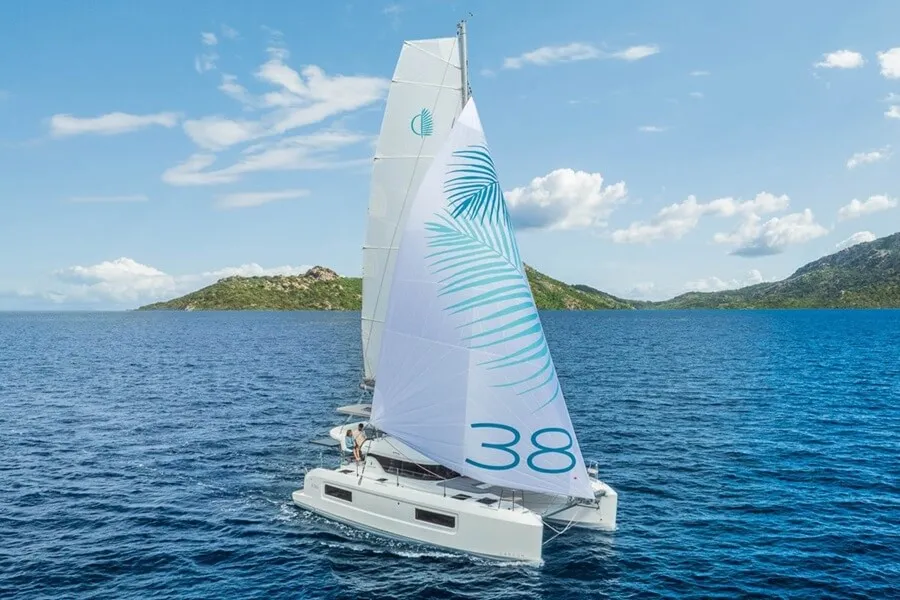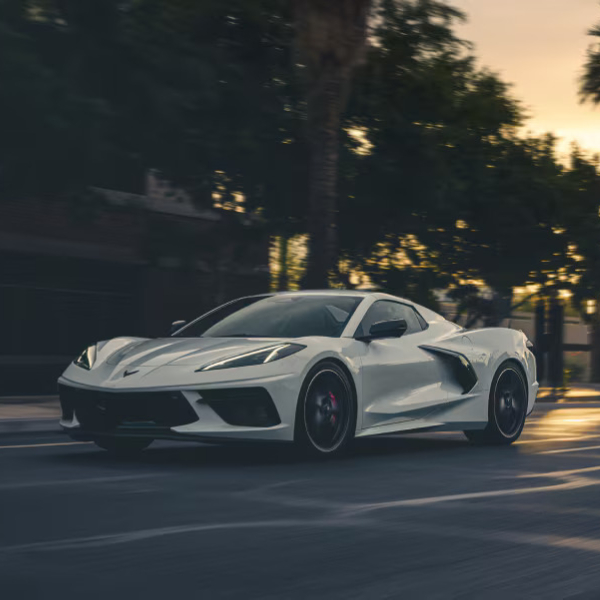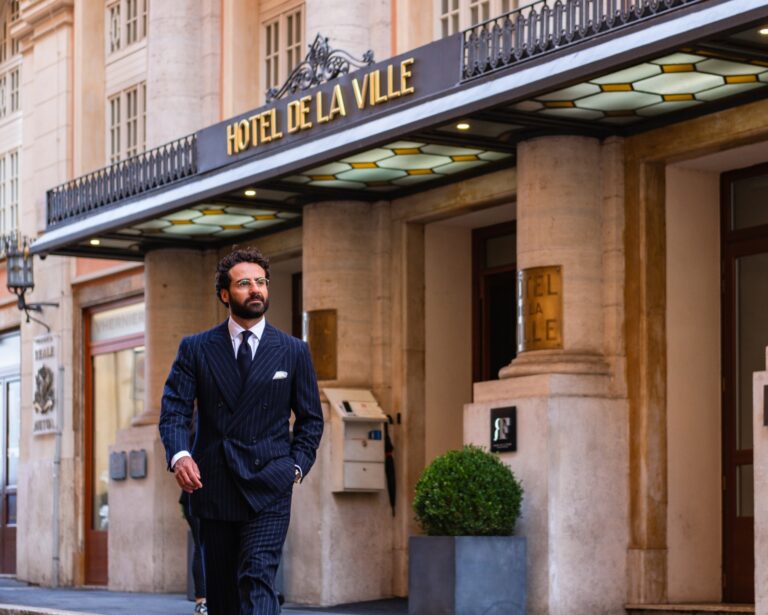Lagoon 38 Fulfils Big Dream for Entry Model

Thomas Gailly encourages the crowd at the Lagoon Exclusive Days to ‘dream big’ as the Brand Director stands aboard a Lagoon 38, the new entry model for the world leader in cruising catamarans, with over 7,300 units built to date.
And as Boris Diaw joins him in inspiring the audience to ‘dream big’, it adds further weight. After all, he’s 6ft 8in tall. On top of that, the Frenchman is an NBA champion, having helped San Antonio Spurs beat Lebron James and the rest of a star-studded Miami Heat side to win the 2014 Finals.
Since then, the Bordeaux-born basketball hero has acquired a Lagoon Seventy 7 and become a friend of the brand, which led to him being appointed ‘Godfather’ of the first Lagoon 38.

The 38 is produced at the brand’s facilities in Vendee, but the first hull was brought to the Construction Navale Bordeaux (CNB) shipyard – builder of Lagoon’s 50ft-plus yachts – for its private premiere during this year’s Lagoon Exclusive Days.
Diaw attended the premiere party and boarded the boat at the finale, popping a celebratory bottle of champagne before joining Gailly in encouraging the crowd to ‘Always Dream Big’, a slogan painted on the yacht’s mainsail.
However, this wasn’t encouragement for yacht owners to upgrade to a bigger boat. It was targeted at those who had dreamed of owning a yacht and had yet to take the plunge. After all, Gailly says that half of Lagoon’s yachts are for first-time boat buyers.

“The 38 is Lagoon’s entry model, so it’s the key boat for us to attract more people to catamarans and Lagoon,” he says. “It’s a very strategic model.”
BIG CHALLENGE
Due to space limitations, a smaller boat can be more challenging to design than a larger one. Compounding the pressure, Lagoon was creating its first 38-footer since the iconic Lagoon 380, which launched in 1999 and became the world’s best-selling catamaran, with close to 1,000 units built across two decades.
Although the 380 has since been succeeded as Lagoon’s bestselling model by the 450 then the 42, it provided an imposing model to improve upon.

However, Lagoon has proved that it has moved on to another level, with the 38 offering greater exterior social space, interior volume, accommodation, visibility, light, comfort and storage.
“The Lagoon 38 was a huge challenge for us and the architects because of the 380, which helped change the history of sailing,” Gailly says. “The 380 helped attract a lot of owners from sailing monohulls to catamarans, and even attracted a lot of first-time owners into boating, because it was simple, easy to handle, safe and a reasonable price.
“To build such a boat today is a challenge because certifications are very different to 20 years ago, the way we build boats is so different, so it took us years to finalise a design we were happy with.”

VPLP Design, founded in 1983 by Marc Van Peteghem and Vincent Lauriot-Prévost, was entrusted with the Lagoon 38’s naval architecture, having worked on every Lagoon model since the brand was founded in 1984. Patrick Le Quement handled exterior styling while Italy’s Nauta Design was responsible for the interiors, as it has been for every Lagoon since 2012.
The 37ft 4in hull has an almost 22ft beam, a 4ft-plus draught and an air draught of over 60ft. The rig includes a sail area of 836sqft, comprising a 600sqft square-top mainsail and 236sqft self-tacking jib, with the option of a Code 0 (581sqft).
Rosalie Le Gall, Lagoon’s Product Director, says: “The 38 is really targeted at first-time owners, or charter programmes for less-experienced skippers, so it’s designed to be easy to sail.”

As part of Lagoon’s increased emphasis on circulation and ease of movement, boarding has been made easy due to extended outer transoms, which can also be used for easy access to the water as well as jumping and diving platforms.
The semi-raised helm station is on the starboard side of the coachroof, which can also include up to 520W of integrated solar panels to port. The option of a further 900W of solar panels on the central transom can help the Lagoon 38 deliver up to 1,420W of clean, emission-free energy.

Forward of the coachroof solar panels is a sunpad, while a C-shaped arrangement of sunpads on the foredeck offers a much larger outdoor lounging area and is a popular place to relax.
IN & OUT
In terms of linking the cockpit and saloon, the Lagoon 38 has been inspired by the Lagoon 43 that debuted in 2024 and introduced the flexible ‘In & Out’ design concept.
Forward of the aft sofa, the covered cockpit has a dining area to port that, once the sliding doors are open, can be adjoined to the indoor dining area by folding out table leaves and moving loose seats to each end. Voila – you have an elongated social area for a dozen or so people, a remarkable option on a sub-38ft hull.


The ‘In & Out’ design allows the outdoor and indoor areas to be adjoined or separated by sliding doors and a moveable bench seat
This is a boat built to handle decent crowds, with a well-equipped galley to starboard that includes lots of storage and a 300-litre fridge.
Le Gall says: “The Lagoon 38 really fits with the spirit of the 43, which represents the brand’s latest generation and has proved a great success. The 38 has many of the same key features but on a smaller boat.”
Like the accommodation on the Lagoon 43, the Lagoon 38 offers either a symmetrical four-cabin, two-head layout, or a three-cabin design featuring a full-length master suite in the port hull. Lagoon is proud to announce that each of the three or double beds is 1.8m wide, which it says is a first for the market and a key attraction for both private owners and charter operators.

Gailly beams: “There is no other sub-40 boat offering four beds this wide and such comfort on board. It’s a big advantage compared to the competition, and a tribute to VPLP Design and Nauta.”
In the three-cabin option, the impressive owner’s suite includes an aft bathroom with a separate shower, a desk and storage area midships, and the bed forward, which offers the benefit of being away from the engines and cockpit chatter, as well as the dock. It’s also worth noting the impressive headroom in the hulls, while there are even berth options for crew or children in the two forepeaks.


Forward view of the full-length master suite, which occupies the port hull in the three-cabin layout
As well as maximising space and focusing on clean energy, Lagoon continues to improve the green credentials of its build operations. The structure of the deck and hulls of the CE-A catamaran is created by vacuum-infusion moulding, a process ensuring lighter weight, a higher quality of composite, and reduced environmental impact by the shipyard.
All-natural hemp fibre has been used instead of fibreglass on non-structural pieces, while Lagoon’s advances in bio-sourced resins and vegetal fibres are also visible. Woodwork comes from FSC-certified forests, and recycled materials are used for the standard upholstery.

As well as a fuel capacity of 400 litres, the yacht can store between 300-500 litres of fresh water, while the UVOJI water purification system is installed as standard and included in a sub-€350,000 base price, with Le Gall stating that a competitive price was another essential.
“The aim for the Lagoon 38 was not only to have the most space and comfort, plus the best features, but also to offer the best price.”
This article was first seen on YachtStyle.com.
For more on the latest in luxury yachting reads, click here.
The post Lagoon 38 Fulfils Big Dream for Entry Model appeared first on LUXUO.





